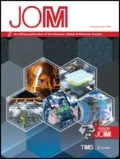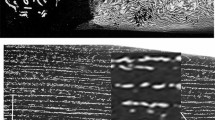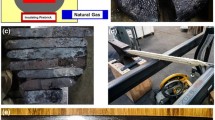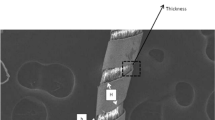Abstract
The art of producing the famous 16–18th century Damascus steel blades found in many museums was lost long ago. Recently, however, research has established strong evidence supporting the theory that the distinct surface patterns on these blades result from a carbide-banding phenomenon produced by the microsegregation of minor amounts of carbide-forming elements present in the wootz ingots from which the blades were forged. Further, it is likely that wootz Damascus blades with damascene patterns may have been produced only from wootz ingots supplied from those regions of India having appropriate impurity-containing ore deposits.
Similar content being viewed by others
References
M. Sache, Damascus Steel, Myth, History, Technology Applications (Düsseldorf, Germany: Stahleisen, 1994).
B. Bronson, “The Making and Selling of Wootz,” Archeomaterials, 1 (1986), pp. 13–51.
W. Rostoker and B. Bronson, “Pre-Industrial Iron, Its Technology and Ethnology,” Archeomaterial Monograph No. 1 (Philadelphia, PA: Archaeomaterials, 1990), p. 127.
L.S. Figiel, On Damascus Steel (Atlantas, FL: Atlantas Arts Press, 1991).
C.S. Smith, A History of Metallography, Chapters 3 and 4 (Cambridge, MA: MIT Press, 1988).
C.S. Smith, “Damascus Steel,” Science, 216 (1983), pp. 242–244.
J. Wadsworth and O.D. Sherby, “Damascus Steel-Making,” Science, 216 (1983), pp. 328–330.
J.D. Verhoeven and D.T. Peterson, “What is Damascus Steel?” Mat. Char., 29 (1992), pp. 355–341.
M. Breant, “Description of a Process for Making Damasked Steel,” Annals of Philosophy, 8 (1824), pp. 267–271.
P. Anossoff and O. Bulatakh, Gornyj Journal (2) (1841), pp. 157–318.
N.T. Belaiew, “Uber Damast,” Metallurgie, 8 (1911), pp. 449–456; “Damast, seine Struktur und Eigenschaften,” Metallurgie, 8 (1911), pp. 699–704; “Damascene Steel,” J. Iron and Steel Inst., 97 (1918), pp. 417–439.
J. Wadsworth and O.D. Sherby, “On the Bulat-Damascus Steel Revisited,” Prog. Mat. Sci., 25 (1980), pp. 35–68.
B. Zschokke, “Du Damasse et des Lames de Damas,” Rev. Met., 21 (1924), pp. 635–669.
J.D. Verhoeven and A.H. Pendray, “The Mystery of the Damascus Sword,” Muse, 2 (2) (April 1998), pp. 35–43.
J.D. Verhoeven and A.H. Pendray, “Experiments to Reproduce the Pattern of Damascus Steel Blades,” Mat. Char., 29 (1992), pp. 195–212.
J.D. Verhoeven, A.H. Pendray, and P.M. Berge, “Studies of Damascus Steel Blades: Part II–Destruction and Reformation of the Pattern,” Mat. Char., 30 (1993), pp. 187–200.
J.D. Verhoeven, A.H. Pendray, and E.D. Gibson, “Wootz Damascus Steel Blades,” Mat. Char., 37 (1996), pp. 9–22.
J.D. Verhoeven et al., “Microsegregation and Banding in Hypereutectoid Steel: Damascus Steel,” ISS Trans., 25 (in press).
E.M. Taleff et al., “Pearlite in Ultrahigh Carbon Steels: Heat Treatments and Mechanical Properties,” Met. Mat. Trans. A, 27A (1996), pp. 111–118.
J.D. Verhoeven and E.D. Gibson, “The Divorced Eutectoid Transformation (DET) in Steel,” Met. Mat. Trans., 29A (1998), pp. 1181–1189.
D.T. Peterson, H.H. Baker, and J.D. Verhoeven, “Damascus Steel, Characterization of One Damascus Steel Sword,” Mat. Char., 24 (1990), pp. 355–374.
Massalski, “Preparation de lacier Damasse en Perse,” Ann. Du Journal des Mines de Russie (1841), pp. 297–308.
H.T.P. J. duc de Luynes, Memoire sur la Fabrication de lacier Foundu et Damassee (Paris: 1844).
C. Panseri, “Damascus Steel in Legend and Reality,” Gladius, IV (1965), pp. 5–66.
R.A. Grange, “Effect of Microstructural Banding in Steel,” Met. Trans., 2 (1971), pp. 417–426.
L.E. Samuals, Optical Microscopy of Carbon Steels (Metals Park, OH: ASM, 1980), pp. 154–161.
S.W. Thompson and P.R. Howell, “Factors Influencing Ferrite/Pearlite Banding and Origin of Large Pearlite Nodules in a Hypoeutectoid Plate Steel,” Mat. Sci. Tech., 8 (1992), pp. 777–784.
R. Grossterlinden et al., “Formation of Pearlite Banded Structures in Ferrite-Pearlite Steels,” Steel Research, 63 (1992), pp. 331–336.
P.T. Craddock, “Cast Iron, Fined Iron, Crucible Steel: Liquid Iron in the Ancient World,” Prehistory of Mining and Extractive Metallurgy, ed. P.T. Craddock and J. Lang (London: British Museum, in press).
H. Maryon, “Pattern Welding and Damascening of Sword Blades Part 2,” J. of Intern. Inst. for Conservation of Hist. and Art. Works, 5 (1960), pp. 52–60.
Author information
Authors and Affiliations
Rights and permissions
About this article
Cite this article
Verhoeven, J.D., Pendray, A.H. & Dauksch, W.E. The key role of impurities in ancient damascus steel blades. JOM 50, 58–64 (1998). https://doi.org/10.1007/s11837-998-0419-y
Issue Date:
DOI: https://doi.org/10.1007/s11837-998-0419-y




